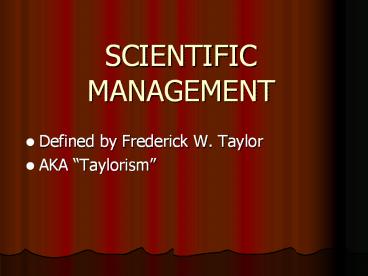SCIENTIFIC MANAGEMENT - PowerPoint PPT Presentation
1 / 16
Title: SCIENTIFIC MANAGEMENT
1
SCIENTIFIC MANAGEMENT
- Defined by Frederick W. Taylor
- AKA Taylorism
2
SCIENTIFIC MANAGEMENT
- Text Book Definition The systematic study of
relationships between people and tasks for the
purpose of redesigning the work process to
increase efficiency.
- Websters New Millennium The administration of
a business or industry based on experimental
studies of efficiency the application of the
principles of the scientific method of managing a
business or industry.
3
Frederick W. Taylor
- Father of scientific management
- Wrote and published Scientific Management in
1911. - Studied how organizations could become
accessories to machines.
4
Taylors Beliefs
- Dispelled the notion of work soldiering
- Term used for loafing
- Worker time and effort spent on a product could
be reduced and the production process can become
more efficient - Increase specialization
- Divide labor
5
Taylors Beliefs
- Remove the old rule of thumb
- Use scientific management techniques by using
time studies - Systematically analyze human behavior at work
- Attempted to reduce human error
- Each task broken down to the smallest unit
- Teach worker-only actions essential to the task
6
Taylors Four Principles Of Scientific Management
- Principle 1 (replace the old rule-of-thumb
methods) - Study the way workers perform their tasks
- Gather informal job knowledge that workers
possess - Experimental ways of improving the way tasks are
performed
7
Taylors Four Principles
- Principle 2
- Organize new methods of performing tasks into
written rules - Standardize new methods into operating procedures
8
Taylors Four Principles
- Principle 3
- Develop a spirit of cooperation between workers
and management - Select workers with skills and abilities that
match the needs of the task - Train workers to perform the tasks according to
the written rules and procedures
9
Taylors Four Principles
- Principle 4
- Establish an acceptable level of performance for
each task - Develop a pay system that rewards performance
above the acceptance level
10
Pros
- Huge savings in cost for organizations
- Dramatic increase in output in large, organized
work settings - Organized operations operated more efficiently
- New departments were created
- Personnel
- quality
- Written rules and procedures were created
11
Cons
- Principles were implemented selectively by
managers - After obtaining performance increase, managers
often rewarded workers with more duties rather
than a monetary bonus - Increase in performance meant fewer jobs and
greater threat of layoffs because fewer workers
were needed - Workers dissatisfied specialized jobs because of
how monotonous and repetitive in nature the jobs
were
12
Frank Lillian Gilbreth
- Associates of Frederick Taylor
- AKA the Mother and Father of Time Motion
Studies - Studied standardization and method study
13
(No Transcript)
14
Gilbreth Beliefs
- Believed they could eliminate wasted time by
tracking worker movements - Incorporated periods of time for the worker to
rest
15
Scientific management today
- No longer valid in todays business world?
- Principles have been modified and updated
- Still used in its most pure form in assembly lines
16
Scientific Management Today
- All scientific management is not Taylorism
- Any form of recording, analyzing, and reporting
data then applying results can be considered
scientific management































